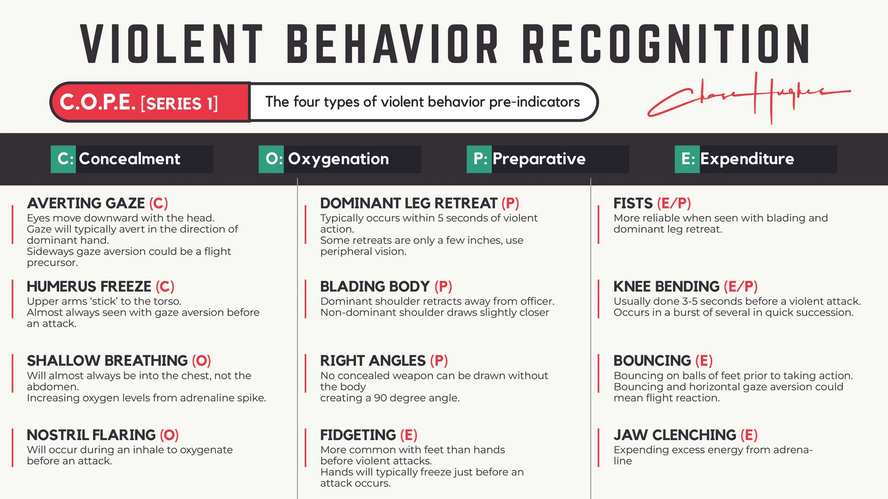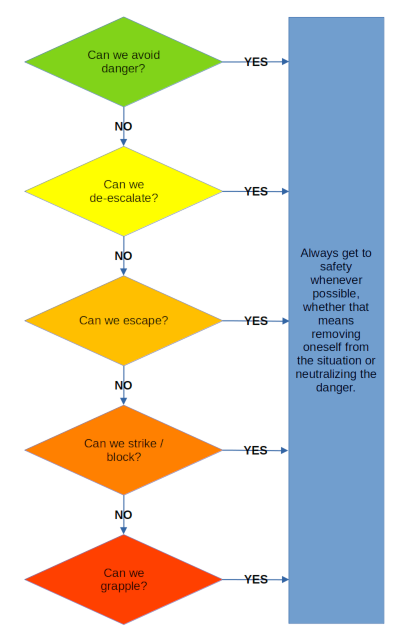

In simple terms, Situational Awareness is being more aware of your surroundings. The real question is, can you develop a sixth sense for danger, while still being able to enjoy each and every moment? This was my personal struggle when I was learning self-defense and when I learned how to bring a workable sense of awareness into my daily routine, I began sharing it with my students. Try these simple drills to increase your sense of situational awareness when you are out in public. It feels great to know that you can become your own personal security agent.The state of one's Situational Awareness is sometimes represented by a simple scale referred to as "Cooper's Colors," named after Jeff Cooper, an army colonel. It follows this pattern:
The next time you step into a coffee shop, transit area or busy commercial building, try to do these simple drills to sharpen your awareness tactics:
1. Peripheral Vision. For the most part, people use direct vision, but it is our peripheral vision that must be used when out in public. Without insulting your friend, attempt to have a conversation and observe what is happening around them, while still maintaining your focus point and listening to what they are saying. Learning this simple tactic, allows you to monitor a wider degree of space and detect something suspicious, leading us to our next point.
2. The Automatic Scan. I call this the automatic scan because we do it naturally everywhere we go. The question is, are we focused on the right thing? Next place you go forget about focusing on things that don't have to do with your personal safety and pay attention to the following:
• Exits: Where are my exits and how accessible are they?
• Barriers: For the good and for the bad. Barriers can get in your way but they can also be used to keep someone away. Find your barriers and see how you could avoid them to reach an exit point, or how you would use them to keep a potential threat on the other side.
• Suspicious Objects: If something doesn't look right, like an unattended bag, immediately notify a worker of the space you are in.
• Suspicious People: This is an obvious one. If someone is suspicious take action to notify others and remove yourself from his or her direct path.
3. Watch Your Back. Instead of looking over your shoulder, place your back against a surface if possible to remove the possibility of someone getting behind you or in your blind spot. This is a great tactic when you are in a crowded area and cannot see everything (e.g. the drunk guy at a party, or a pushing crowd in the subway). In the next crowd you are in, try to identify strategic surfaces that you could stand in front of or lean against.
4. Make Reflective Surfaces Your Ally. Reflective surfaces can work to your advantage because they can reveal what is going on either behind you or somewhere outside of your peripheral vision. For example, the next time you walk down a commercial street, use the display windows to help you see behind you.
5. Stop and Pretend. If you feel someone is following you, I always tell my students to do the classic stop, turn and pretend like you went the wrong way. Let the suspicious person pass you, and if he doesn't or reroutes to follow you, you can now confirm that you might have a potential attacker. Please note that this also applies to safety driving tactics of letting a car pass you if you feel you are being followed.
6. Become a Hard Target. Maintaining an appearance of confidence in your manner is very important to how vulnerable you appear to a potential attacker. But further to this, if you come across as very aware of your surroundings -- people, physical locations and interpersonal interactions -- then you become much less prone to being taken by surprise of any type of attack or threat of violence.
7. Your Invisible Circles. We all have a sense of our personal boundaries of space or the distance we naturally keep when standing near strangers (just pay attention next time you enter an elevator and watch everyone gravitate to the furthest corners). When someone invades your personal space you should be aware of several things.
• Look at their hands. Are they holding a weapon or showing any intent of causing harm?
• Look for any bulges. Are there any bulges coming from their clothes that could indicate a weapon?
• Overall, are they demonstrating verbal aggression or body language?
For all of the above, immediately increase the distance between yourself and this person. Generally, a five to six-foot distance allows you time to react and assess the situation for any further action on your part.
8. Visualization. Practice safety by using visualization to assess a threatening situation and determine your actions. Take the time to visualize yourself in threatening situations and determine how you would react, assess and protect yourself from danger. By mentally visualizing different scenarios you will develop a strong set of awareness skills and leave little to chance if ever confronted by a violent threat or attack.
9. Intuition. Much is written about following your gut instinct and as much has been written about how we ignore its signals. We have all experienced a visceral reaction to situations where things just didn't add up and signified some type of threat or danger. Please pay attention to these feelings or reactions -- they will alert you, and if you listen, help to protect you. Adhering to these warning signs can obviously be applied to physical threats, but can also act to warn you about people with questionable integrity.
Again, I want to reiterate that situational awareness is one of the major keys to keeping yourself safe. I always say that 90 percent of the threats and attacks you could potentially face are preventable. If you consciously make the decision to adhere to these concepts you are well on your way to living a safe life!
| WHITE | Unaware and unprepared, tuned out |
|---|---|
| YELLOW | Relaxed and alert |
| ORANGE | Aware of possible danger, ready to act |
| RED | Threat identified, taking decisive action |
| BLACK | Panic, freeze, and breakdown of defense |
"Street smarts" plays down the appearance of "wealth". Unless you want to get mugged, don't walk around in the "ghetto" with a Rolex on. Don't stare, or people will take that as a challenge and try to beat you up. Don't wear clothing all of a single color or you will be mistaken for a "gang member" and end up dead if you cross the "wrong" street. You learn pretty quickly what to avoid when your life is at stake.Sometimes it is best to avoid locations because of the events that are likely to occur there. That does not make someone a "coward". Putting ourselves in unnecessary danger is foolish, not brave. For example, an alleyway is probably not the safest place to be at midnight. While it might seem unreasonable to some, that would also include places like bars. Alcohol and drug use inhibit awareness.

